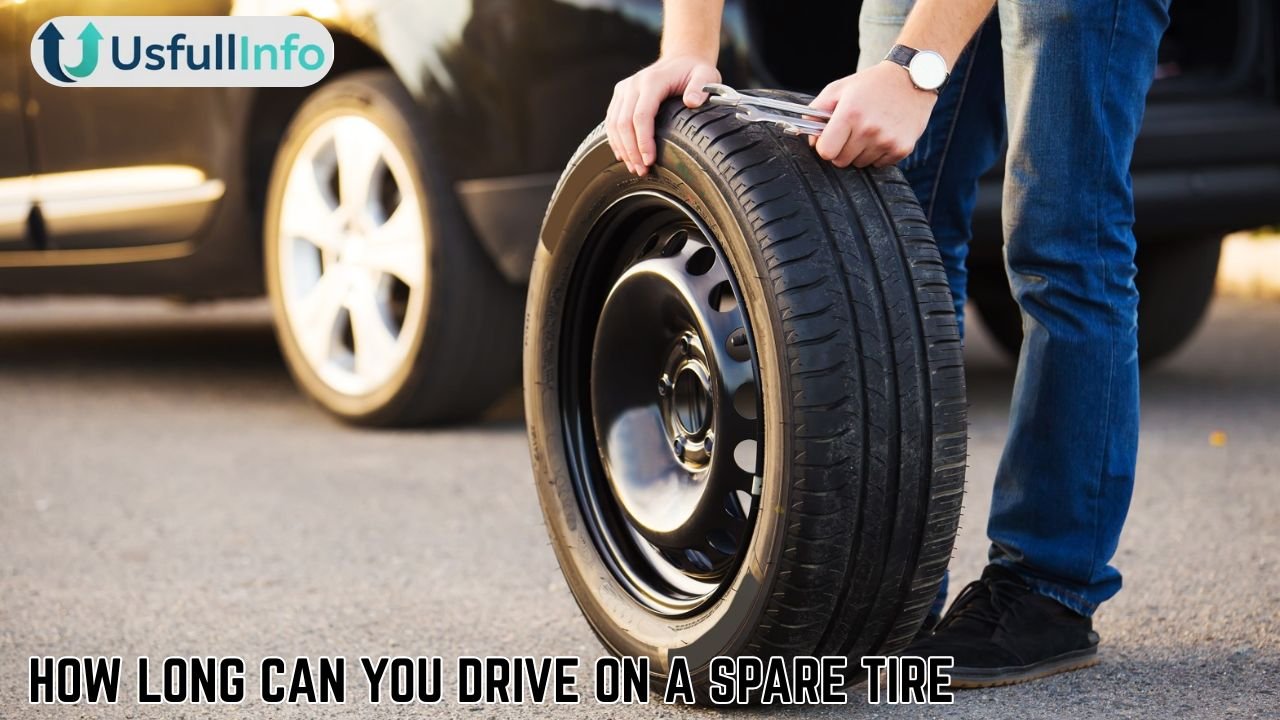Experiencing a flat tire is never convenient, but knowing how long you can drive on a spare tire can help you stay safe and prepared. Whether you’re dealing with a donut tire or a full-size spare tire, understanding the limitations of these temporary solutions is crucial for maintaining tire safety and avoiding further issues. Most spare tires are designed for short distances and temporary use, but there are important factors to consider, such as speed limitations, air pressure, and the type of spare tire your vehicle has.
Spare tires are meant to act as a safety net, allowing you to get back on the road and reach a tire shop or service center. However, improper usage or extending their usage beyond recommended limits can lead to wear and tear, reduced traction, or even tire failure. In this guide, we’ll cover the different types of spare tires, their intended purposes, and how to drive safely with a temporary solution.
Types of Spare Tires and Their Purposes
Full-Size Spare Tire vs. Donut Spare Tire
A full-size spare tire is a spare wheel that functions just like a standard tire on your vehicle. It is built for longer-term use and provides the same performance, load rating, and tread life as your normal tire. Full-sized spares are commonly found in larger vehicles like trucks and SUVs, as they offer the advantage of maintaining stability and handling similar to regular tires. However, they take up significant space in your vehicle and may not be included in some new vehicles due to weight and space considerations.
On the other hand, a donut spare tire, also called a compact temporary spare, is much smaller and lighter than a full-size tire. These are designed for short distances and temporary use only, serving as a quick fix to get you safely off the side of the road and to a tire shop. While donut tires are convenient due to their smaller size and ability to save trunk space, they come with usage restrictions such as lower speed limits and shorter mileage capabilities. Their reduced tread depth and smaller wheel size mean they offer less traction and durability compared to standard tires.
Space-Saver and Compact Temporary Spares
Space-saver spare tires are a specific type of donut tire that automakers include in many new vehicles to optimize trunk space. These smaller space-saver tires are lightweight and easy to store, making them ideal for compact cars and sedans. However, their design prioritizes size and weight savings over performance, which means they are not suitable for extended periods or longer distances.
These compact temporary spare tires come with strict usage restrictions outlined in your owner’s manual. Typically, they are limited to a maximum speed of 50 mph and a driving range of about 50 to 70 miles. These limitations ensure that you use them as a temporary solution until you can get a permanent tire replacement. Ignoring these restrictions can lead to tire failure, reduced safety, and potential damage to your vehicle.
How Far and Fast Can You Drive on a Spare Tire?
Understanding Speed and Distance Limits
When using a spare tire, it’s important to follow its speed and distance limitations to maintain tire safety. Most temporary spare tires, including donut spare tires and compact temporary spares, are designed to be driven at speeds of no more than 50 mph. Driving at high speeds can cause increased wear and tear, reduce tread life, and even lead to a blowout.
As for distance, most temporary spare tires are not intended for longer distances. They are usually rated for a maximum mileage of 50 to 70 miles. This range is sufficient to get you to a nearby tire store or service center but should not be relied upon for extended periods or road trips. Ignoring these speed limitations and mileage recommendations can compromise your safety and lead to additional vehicle maintenance issues.
Impact of Tire Condition and Air Pressure
The condition of your spare tire plays a critical role in its performance and safety. Before driving on a spare tire, check its inflation pressure and ensure it meets the recommended levels specified in your owner’s manual. Under-inflated or over-inflated spare tires can affect handling, braking, and overall safety. Additionally, examine the tread depth for signs of wear and tear, as older tires or those stored for an extended period may offer less traction.
If your spare tire shows visible damage, cracks, or an insufficient amount of wear remaining on the tread, it’s a good idea to replace it. Using a damaged or worn-out spare can lead to unsafe driving conditions and increase the risk of tire failure. Keeping your spare tire in good condition ensures it’s ready when you need it most.
When and Where to Replace a Spare Tire
Signs You Need a New Tire
Knowing when to replace a spare tire is essential for maintaining vehicle safety. If your spare tire shows signs of excessive wear, such as shallow tread depth or visible cracks, it’s time to replace it. Additionally, if your spare tire is older than its recommended shelf life, it may no longer be reliable. Most automakers suggest replacing a spare tire after six to ten years, even if it has never been used, as the rubber can degrade over time.
Another clear sign you need a new tire is if your current spare has been used multiple times or has visible damage from previous use. A worn-out spare should not be relied upon, as it can compromise your safety and the performance of your vehicle. Investing in a new tire promptly is a crucial step in responsible vehicle maintenance.
Finding a Tire Shop or Service Center
When it’s time to replace your spare tire, search vehicles by zip code to locate a reliable tire shop or service center near you. Many tire stores and service & parts departments offer service specials and open today sales, making it easier to find affordable options for tire replacement. Some locations also provide finance service plans to help with the cost of a new tire.
Visiting a professional tire shop or our service center ensures that your spare tire replacement is done correctly. Service experts can also inspect your vehicle for any additional issues caused by the use of a temporary tire and recommend solutions to maintain the health of your car tires.
Tips for Safe Driving with a Temporary Spare Tire
Maintaining Spare Tires in Good Condition
To ensure your spare tire is ready when you need it, regularly check its inflation pressure using a tire pressure monitor. Refer to your owner’s manual for specific guidelines on maintaining the type of spare tire your vehicle uses. Keeping your spare in good condition reduces the risk of complications during emergencies and extends its usability.
It’s also important to store your spare tire properly. Keep it in a clean, dry area to prevent premature wear and tear. If you’re using a compact spare or space-saver spare tire, periodically inspect it for signs of aging or damage, especially if it hasn’t been used in a long time. Proper maintenance of your spare tire acts as a safety net in case of unexpected tire failure.
Driving Safely with a Temporary Solution
When driving on a temporary spare tire, avoid high speeds, sharp turns, and sudden braking. These actions can put additional strain on your spare tire and increase the likelihood of tire failure. Stick to speed limitations and use your spare only for short distances to ensure your safety.
Plan to visit a tire shop or service center as soon as possible after experiencing a flat tire. Promptly replacing your spare with a new tire minimizes the risks associated with temporary use and restores your vehicle’s performance. Remember, spare tires are a temporary solution, not a permanent fix, so prioritize getting back to regular tires quickly.
Important Points to Remember About Spare Tires
Spare tires are designed to be a temporary solution, allowing you to drive safely for short distances after a flat tire. However, they are not meant for longer distances or extended periods. Whether you are using a donut spare tire, a compact temporary spare, or a full-size spare, it’s essential to adhere to the recommended speed limitations and mileage restrictions provided by automakers. Ignoring these guidelines can compromise tire safety and result in unnecessary wear and tear on your vehicle.
If you find yourself frequently relying on your spare tire, it may be time to address underlying issues such as older tires or a lack of proper vehicle maintenance. Regularly inspecting your car tires and replacing them as needed can help you avoid emergencies. Additionally, if you’re unsure about your spare tire’s condition or capabilities, consult your owner’s manual or visit a trusted service center for advice. Service experts can provide valuable insight into the tread depth, inflation pressure, and overall safety of your spare tire.
For those on a budget, many tire stores and service & parts departments offer options such as finance service plans and service specials. These can help you afford a new tire without compromising on quality or safety. Whether you drive a new truck, an older car, or a compact sedan, maintaining a reliable spare tire and staying informed about its proper use is a good idea for every driver.








